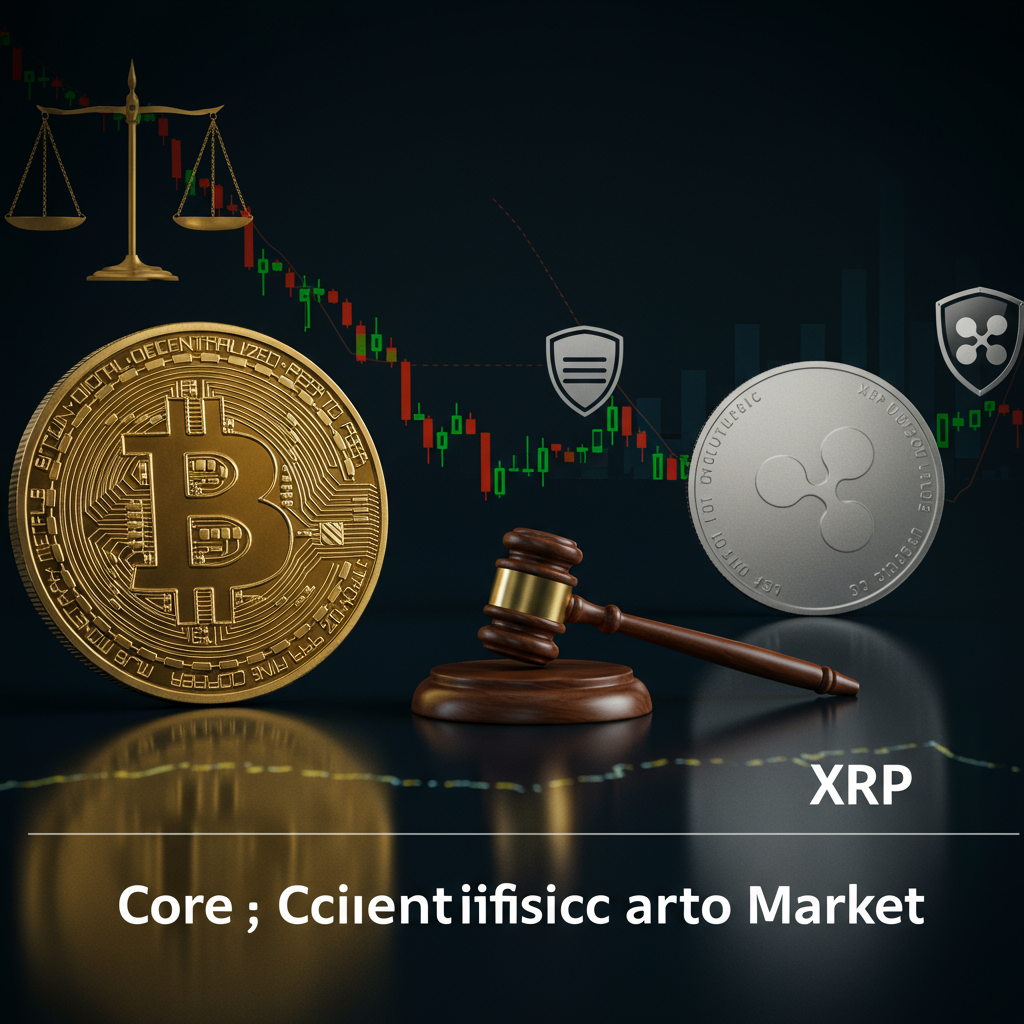The digital asset market continues its dynamic trajectory, marked by significant corporate maneuvers and ongoing regulatory discussions. Recent developments saw a surprising downturn for a major player while another prominent cryptocurrency navigates price volatility and shifting regulatory landscapes. This article delves into the key events shaping the current crypto conversation, focusing on the unexpected turn for Core scientific and the latest analysis surrounding XRP’s price and future prospects.
Core Scientific Stock Plunges Despite Massive AI Acquisition
Core Scientific, a company known for its past in Bitcoin mining, experienced a notable drop in its stock price recently. This downturn followed the announcement of a massive acquisition agreement. AI infrastructure leader coreweave has agreed to acquire Core Scientific in an all-stock transaction valued at approximately $9 billion.
The strategic motivation behind this significant deal is primarily focused on dramatically expanding CoreWeave’s capacity for AI and high-performance computing (HPC). It is less about Core Scientific’s history in the cryptocurrency sector. CoreWeave is making a bold move to secure essential power infrastructure for the burgeoning AI industry.
The CoreWeave Deal Details
The acquisition offers Core Scientific shareholders $20.40 per share. This represents a substantial 66% premium compared to the stock’s closing price just before the announcement. However, despite this generous offer, market reaction saw Core Scientific shares slide 13.4% following the news. CoreWeave’s stock also experienced a drop, falling 6%.
The transaction is projected to finalize in the fourth quarter of 2025. Upon completion, CoreWeave estimates that existing Core Scientific shareholders will collectively hold less than 10% of the combined entity. This indicates a significant shift in ownership structure.
A Strategic Power Play for AI
This acquisition marks the latest step in CoreWeave’s interest in Core Scientific’s assets. CoreWeave had previously made a $1 billion bid and secured long-term contracts for a substantial amount of Core Scientific’s infrastructure power. The current deal provides access to a much larger prize. It secures roughly 1.3 gigawatts of power capacity immediately available.
Furthermore, the deal provides access to an additional 1 GW or more for planned future expansion. This scale is equivalent to the output of a nuclear plant. Securing this power is deemed critical for CoreWeave’s ambitious AI infrastructure goals.
Core Scientific, since emerging from bankruptcy, has been pivoting its business. It has been moving away from primarily Bitcoin mining. Instead, it has been focusing on AI data hosting. This shift made it a key infrastructure partner for CoreWeave even before this acquisition.
The Race for AI Infrastructure
The acquisition takes place within a rapidly accelerating race for AI infrastructure. CoreWeave CEO Michael Intrator stated that acquiring Core Scientific will significantly accelerate his company’s ability to deploy AI and HPC workloads at scale. This highlights the urgent need for such capacity across the tech industry.
Beyond securing physical assets, the acquisition brings Core Scientific’s experienced team to CoreWeave. This team has over 150 years of combined expertise in data center construction and management. This is expected to mitigate risks as CoreWeave expands its role into owning and operating these large facilities.
Financially, the all-stock transaction leads to potential stock dilution for CoreWeave. However, it is framed as leveraging CoreWeave’s valuable stock. The goal is to acquire essential physical assets that are difficult and time-consuming to build from scratch.
Significant long-term financial benefits are anticipated. CoreWeave projects eliminating over $10 billion in future data center lease costs. Additionally, the company forecasts annual cost savings of $500 million by the end of 2027.
As Core Scientific was already CoreWeave’s largest customer, the acquisition is viewed strategically. CoreWeave is effectively paying itself instead of a landlord. This aims for a more profitable and predictable business model.
Concerns about Core Scientific’s background as a Bitcoin mining company are addressed by its ongoing business transformation. The company is converting older facilities into modern, high-density data centers. These are specifically designed for AI workloads.
This transition is yielding results. In a recent quarter (Q1 2025), Core Scientific’s legacy crypto-mining business had a gross margin of only 9%. In contrast, the newer high-density colocation and digital assets business, which is CoreWeave’s primary interest, showed a significantly higher gross margin of 46%. This demonstrates that CoreWeave is acquiring a partner already accelerating a more profitable business line focused on high-demand AI needs.
XRP Navigates Price Volatility and Regulatory Headwinds
Separately in the digital asset space, the cryptocurrency XRP has been a subject of considerable discussion regarding its investment prospects. XRP’s price has seen significant volatility over the past year. It has traded between approximately $0.39 and $3.40.
Recently, XRP pulled back more than 30% from its 52-week high. It is currently trading around $2.20. This price point remains over 40% below its all-time high of $3.84, set back in January 2018. This recent price action has investors questioning its near-term potential.
The Historical Context of XRP
XRP was created in 2012 by Ripple Labs. The fintech company aimed to offer a faster, cheaper, and more secure alternative to the traditional SWIFT protocol for international money transfers. XRP was designed to function as a bridge currency in this system.
Ripple pre-mined the entire 100 billion token supply. 80 billion tokens were allocated to the company, and 20 billion went to the founders. Ripple funded its expansion by selling company-held XRP tokens. This practice became central to its legal challenges.
In 2020, the Securities and Exchange Commission (SEC) sued Ripple. The SEC alleged the company was selling unlicensed securities through its XRP token sales. This lawsuit had significant repercussions for XRP. Major exchanges delisted the token, and Ripple lost customers.
A Turning Point and Potential Catalysts
A crucial development occurred in July 2023. A court ruled that XRP itself was not an unlicensed security in its programmatic sales. However, the broader SEC lawsuit against Ripple continued. This ruling prompted major crypto exchanges to relist XRP.
The lawsuit eventually concluded in August 2023 with a lighter-than-expected fine for Ripple. While the SEC initially appealed parts of this ruling, rumors have surfaced suggesting the appeal may be dropped entirely. The potential dissipation of these regulatory headwinds in late 2024, coupled with broader market factors, had driven XRP’s price up before its recent pullback. Following the regulatory clarity, interest in XRP investment products has increased. Grayscale reopened its XRP Trust, and several firms have applied for new XRP ETFs.
Looking ahead, several potential catalysts could impact XRP’s price:
Formal clarification from the SEC: An official statement or the dropping of the appeal confirming XRP is not a security could significantly boost financial institution adoption.
Ripple’s application for a U.S. banking license: Approval could facilitate using XRP as a liquidity bridge for fiat transfers, particularly in high-remittance markets.
Pilot programs with central banks: Ripple is exploring the use of XRP to bridge liquidity between national central bank digital currencies (CBDCs).
Potential SEC approval of XRP ETFs: This could open the door to significant retail and institutional investment flows.
Valuation and Outlook
Unlike some other cryptocurrencies like Bitcoin, whose value is often linked to scarcity and mining costs, or early Ethereum, valued by its developer ecosystem, XRP’s valuation is different. It is a deflationary token, with a small amount burned per transaction. No new tokens can be minted.
However, XRP has a large circulating supply, currently around 59 billion coins. This large supply affects potential price movements. Developers are also working to add smart contract functionality to the XRP Ledger, suggesting potential for future decentralized applications (dApps).
Despite potential catalysts and technical developments, some analysis remains cautious about XRP reaching the $4 mark soon. Near-term price targets are often cited around $3. Driving the price to $4 would require a substantial 75% rally from recent levels. This would push its market cap close to Ether’s current valuation.
The large circulating supply could limit significant price upside unless very large investors enter the market with substantial capital. While the downside potential for XRP may seem limited at current levels according to some views, reaching higher targets requires specific positive developments to materialize.
Many analysts suggest that XRP is likely to remain below $4 for a considerable time. It may struggle to gain significant further momentum without all the potential catalysts aligning perfectly. Given this outlook, some investors currently prefer established assets like Bitcoin or Ether over XRP for near-term investment.
These two distinct stories—Core Scientific’s acquisition driven by the booming AI sector’s infrastructure needs and XRP’s navigation of regulatory clarity and market volatility—highlight the diverse forces at play within the broader digital asset and technology landscape. Both demonstrate how traditional corporate strategy, technological advancements, and regulatory factors continue to shape the future of these evolving markets.
Frequently Asked Questions
Why did Core Scientific’s stock drop after CoreWeave’s high buyout offer?
Core Scientific’s stock fell despite a 66% premium offer ($20.40/share) from CoreWeave primarily due to market skepticism about the deal’s integration complexity and potential dilution for CoreWeave shareholders, whose stock also dropped. While the offer itself was generous, the market reaction reflected concerns about the long timeline (Q4 2025 closing) and the challenges of merging two large entities, overshadowing the immediate premium for Core Scientific investors in the short term.
Should investors consider buying XRP now based on recent events?
According to analysis from the provided summary, caution is advised regarding buying XRP specifically with expectations of quickly surpassing $4. While regulatory clarity from the SEC lawsuit (ruling XRP itself is not a security) and potential catalysts like ETF approvals or banking licenses exist, the token faces challenges like a large circulating supply. Driving the price significantly higher requires a substantial increase in market capitalization, and some experts currently prefer Bitcoin or Ether as investments over XRP given XRP’s valuation dynamics and the need for multiple positive events to align.
What is the main reason CoreWeave is acquiring Core Scientific?
The primary motivation for CoreWeave acquiring Core Scientific is not Core Scientific’s history as a Bitcoin miner, but rather to secure massive power capacity and data center infrastructure for CoreWeave’s rapidly expanding AI and high-performance computing (HPC) business. CoreWeave needs significant power (initially gaining access to 1.3 GW) to run power-hungry AI chips. The acquisition allows CoreWeave to transition from renting power/space to owning it, securing a critical resource in the competitive AI infrastructure race and gaining access to Core Scientific’s expertise in data center operations.
Conclusion
The recent CoreWeave acquisition of Core Scientific underscores the increasing demand for robust infrastructure, driven not only by traditional digital asset operations but increasingly by the burgeoning field of artificial intelligence. This $9 billion deal highlights a strategic pivot using assets historically linked to Bitcoin mining to serve the high-compute needs of AI. Meanwhile, cryptocurrencies like XRP continue to navigate their own challenges, influenced heavily by regulatory outcomes and market sentiment. Watching how these different segments of the digital and technological landscape converge and evolve will be crucial for understanding future market movements and investment opportunities.
Word Count Check: 1190



